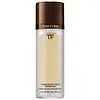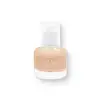What's inside
What's inside
 Key Ingredients
Key Ingredients

 Benefits
Benefits

 Concerns
Concerns

 Ingredients Side-by-side
Ingredients Side-by-side

Methyl Trimethicone
Skin ConditioningWater
Skin ConditioningDimethicone
EmollientCaprylic/Capric Triglyceride
MaskingIsocetyl Alcohol
EmollientButylene Glycol
HumectantLauryl PEG-9 Polydimethylsiloxyethyl Dimethicone
Skin ConditioningPEG/PPG-18/18 Dimethicone
EmulsifyingPolymethyl Methacrylate
Trimethylsiloxysilicate
EmollientDimethicone/Vinyl Dimethicone Crosspolymer
Skin ConditioningPhenyl Trimethicone
Skin ConditioningHdi/PPG/Polycaprolactone Crosspolymer
Sodium Hyaluronate
HumectantSilybum Marianum Extract
Skin ConditioningLaminaria Saccharina Extract
Skin ProtectingCorallina Officinalis Extract
Skin ConditioningSigesbeckia Orientalis Extract
Skin ConditioningCucumis Sativus Fruit Extract
EmollientTetrahexyldecyl Ascorbate
AntioxidantAcetyl Hexapeptide-8
HumectantCaffeine
Skin ConditioningLactis Proteinum
Skin ConditioningYeast Extract
Skin ConditioningTocopheryl Linoleate/Oleate
AntioxidantGlycerin
HumectantTrehalose
HumectantMethicone
EmollientCaprylyl Glycol
EmollientSaccharomyces Lysate Extract
HumectantPropylene Glycol Dicaprate
EmollientHelianthus Annuus Seed Extract
Skin ConditioningLavandula Angustifolia Oil
MaskingAcetyl Glucosamine
Skin ConditioningCholesterol
EmollientHordeum Vulgare Extract
EmollientGlycine Soja Protein
EmulsifyingSilica
AbrasiveLecithin
EmollientSodium Chloride
MaskingMagnesium Aluminum Silicate
AbsorbentDisteardimonium Hectorite
StabilisingLauryl Methyl Gluceth-10 Hydroxypropyldimonium Chloride
Dimethicone Silylate
Xanthan Gum
EmulsifyingPEG-4 Dilaurate
EmulsifyingCalcium Chloride
AstringentLinalool
PerfumingBHT
AntioxidantDisodium EDTA
Potassium Sorbate
PreservativePhenoxyethanol
PreservativeCI 77891
Cosmetic ColorantCI 77492
Cosmetic ColorantCI 77491
Cosmetic ColorantCI 77499
Cosmetic ColorantMethyl Trimethicone, Water, Dimethicone, Caprylic/Capric Triglyceride, Isocetyl Alcohol, Butylene Glycol, Lauryl PEG-9 Polydimethylsiloxyethyl Dimethicone, PEG/PPG-18/18 Dimethicone, Polymethyl Methacrylate, Trimethylsiloxysilicate, Dimethicone/Vinyl Dimethicone Crosspolymer, Phenyl Trimethicone, Hdi/PPG/Polycaprolactone Crosspolymer, Sodium Hyaluronate, Silybum Marianum Extract, Laminaria Saccharina Extract, Corallina Officinalis Extract, Sigesbeckia Orientalis Extract, Cucumis Sativus Fruit Extract, Tetrahexyldecyl Ascorbate, Acetyl Hexapeptide-8, Caffeine, Lactis Proteinum, Yeast Extract, Tocopheryl Linoleate/Oleate, Glycerin, Trehalose, Methicone, Caprylyl Glycol, Saccharomyces Lysate Extract, Propylene Glycol Dicaprate, Helianthus Annuus Seed Extract, Lavandula Angustifolia Oil, Acetyl Glucosamine, Cholesterol, Hordeum Vulgare Extract, Glycine Soja Protein, Silica, Lecithin, Sodium Chloride, Magnesium Aluminum Silicate, Disteardimonium Hectorite, Lauryl Methyl Gluceth-10 Hydroxypropyldimonium Chloride, Dimethicone Silylate, Xanthan Gum, PEG-4 Dilaurate, Calcium Chloride, Linalool, BHT, Disodium EDTA, Potassium Sorbate, Phenoxyethanol, CI 77891, CI 77492, CI 77491, CI 77499
Water
Skin ConditioningCyclopentasiloxane
EmollientTitanium Dioxide
Cosmetic ColorantGlycerin
HumectantHydrogenated Polydecene
EmollientDimethicone
EmollientDipropylene Glycol
HumectantPhenyl Trimethicone
Skin ConditioningPEG-10 Dimethicone
Skin ConditioningDisteardimonium Hectorite
StabilisingMagnesium Sulfate
Cetyl PEG/PPG-10/1 Dimethicone
EmulsifyingPentylene Glycol
Skin ConditioningCamellia Sinensis Leaf Water
MaskingMethyl Methacrylate Crosspolymer
Dimethicone/Vinyl Dimethicone Crosspolymer
Skin ConditioningAcrylates/Dimethicone Copolymer
Skin Conditioning1,2-Hexanediol
Skin ConditioningPalmitic Acid
EmollientAluminum Hydroxide
EmollientGlyceryl Caprylate
EmollientCaprylyl Glycol
EmollientTriethoxycaprylylsilane
Synthetic Fluorphlogopite
Ethylhexylglycerin
Skin ConditioningMyristic Acid
CleansingStearic Acid
CleansingTocopherol
AntioxidantCI 77492
Cosmetic ColorantCI 77491
Cosmetic ColorantCI 77499
Cosmetic ColorantWater, Cyclopentasiloxane, Titanium Dioxide, Glycerin, Hydrogenated Polydecene, Dimethicone, Dipropylene Glycol, Phenyl Trimethicone, PEG-10 Dimethicone, Disteardimonium Hectorite, Magnesium Sulfate, Cetyl PEG/PPG-10/1 Dimethicone, Pentylene Glycol, Camellia Sinensis Leaf Water, Methyl Methacrylate Crosspolymer, Dimethicone/Vinyl Dimethicone Crosspolymer, Acrylates/Dimethicone Copolymer, 1,2-Hexanediol, Palmitic Acid, Aluminum Hydroxide, Glyceryl Caprylate, Caprylyl Glycol, Triethoxycaprylylsilane, Synthetic Fluorphlogopite, Ethylhexylglycerin, Myristic Acid, Stearic Acid, Tocopherol, CI 77492, CI 77491, CI 77499
 Reviews
Reviews

Ingredients Explained
These ingredients are found in both products.
Ingredients higher up in an ingredient list are typically present in a larger amount.
Caprylyl Glycol is a humectant and emollient, meaning it attracts and preserves moisture.
It is a common ingredient in many products, especially those designed to hydrate skin. The primary benefits are retaining moisture, skin softening, and promoting a healthy skin barrier.
Though Caprylyl Glycol is an alcohol derived from fatty acids, it is not the kind that can dry out skin.
This ingredient is also used as a preservative to extend the life of products. It has slight antimicrobial properties.
Learn more about Caprylyl GlycolCi 77491 is also hydrated iron III oxide. It's sole purpose is to give a red/pink hue to products.
Iron III oxides are classified as inorganic chemicals for coloring.
Synthetically created Ci 77491 is considered safer than those naturally found. This is because the synthetically created version may contain less impurities. Iron oxides are generally non-toxic and non-allergenic.
Learn more about CI 77491Ci 77492 is also hydrated iron III oxide. It's sole purpose is to give a yellow hue to products.
Iron III oxides are classified as inorganic chemicals for coloring.
Synthetically created Ci 77492 is considered safer than those naturally found. This is because the synthetically created version may contain less impurities. Iron oxides are generally non-toxic and non-allergenic.
Learn more about CI 77492Ci 77499 is also hydrated iron III oxide. It is created from mixing red and black iron oxides. This helps give shades of darkness to a product.
Iron III oxides are classified as inorganic chemicals for coloring.
Dimethicone is a type of synthetic silicone created from natural materials such as quartz.
What it does:
Dimethicone comes in different viscosities:
Depending on the viscosity, dimethicone has different properties.
Ingredients lists don't always show which type is used, so we recommend reaching out to the brand if you have questions about the viscosity.
This ingredient is unlikely to cause irritation because it does not get absorbed into skin. However, people with silicone allergies should be careful about using this ingredient.
Note: Dimethicone may contribute to pilling. This is because it is not oil or water soluble, so pilling may occur when layered with products. When mixed with heavy oils in a formula, the outcome is also quite greasy.
Learn more about DimethiconeThis ingredient is a silicone used to improve the texture of products and absorb oil. It does not get absorbed into the skin.
Like other silicones, Dimethicone/Vinyl Dimethicone Crosspolymer helps condition the skin by creating a barrier. In this sense, it can act as an emollient and trap moisture in.
This ingredient is a type of elastomer.
Learn more about Dimethicone/Vinyl Dimethicone CrosspolymerDisteardimonium Hectorite comes from the clay mineral named hectorite. It is used to add thickness to a product.
It can also help stabilize a product by helping to disperse other ingredients.
Hectorite is a rare, white clay mineral.
Learn more about Disteardimonium HectoriteGlycerin is already naturally found in your skin. It helps moisturize and protect your skin.
A study from 2016 found glycerin to be more effective as a humectant than AHAs and hyaluronic acid.
As a humectant, it helps the skin stay hydrated by pulling moisture to your skin. The low molecular weight of glycerin allows it to pull moisture into the deeper layers of your skin.
Hydrated skin improves your skin barrier; Your skin barrier helps protect against irritants and bacteria.
Glycerin has also been found to have antimicrobial and antiviral properties. Due to these properties, glycerin is often used in wound and burn treatments.
In cosmetics, glycerin is usually derived from plants such as soybean or palm. However, it can also be sourced from animals, such as tallow or animal fat.
This ingredient is organic, colorless, odorless, and non-toxic.
Glycerin is the name for this ingredient in American English. British English uses Glycerol/Glycerine.
Learn more about GlycerinPhenyl Trimethicone is a silicon-based polymer. It is derived from silica.
Phenyl Trimethicone is used as an emollient and prevents products from foaming.
As an emollient, it helps trap moisture in the skin. It is considered an occlusive.
Learn more about Phenyl TrimethiconeWater. It's the most common cosmetic ingredient of all. You'll usually see it at the top of ingredient lists, meaning that it makes up the largest part of the product.
So why is it so popular? Water most often acts as a solvent - this means that it helps dissolve other ingredients into the formulation.
You'll also recognize water as that liquid we all need to stay alive. If you see this, drink a glass of water. Stay hydrated!
Learn more about Water